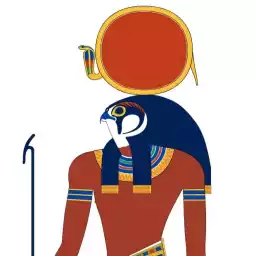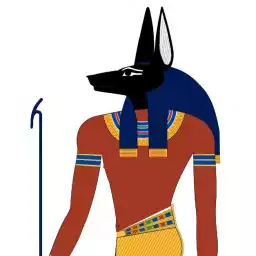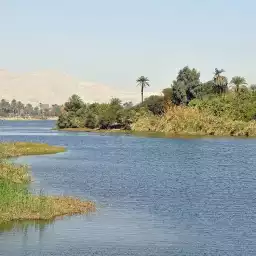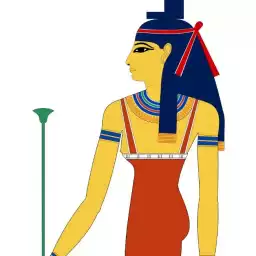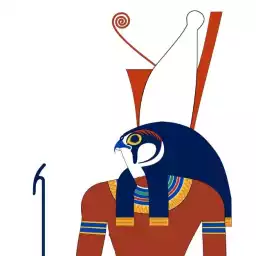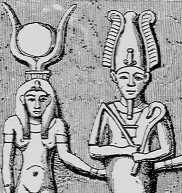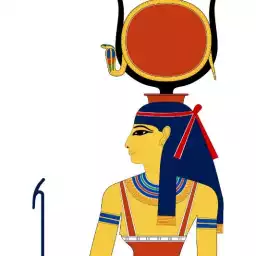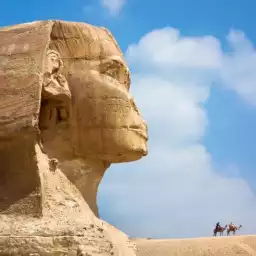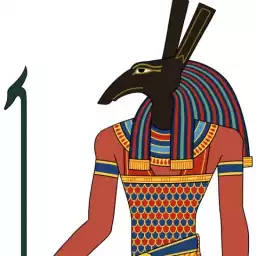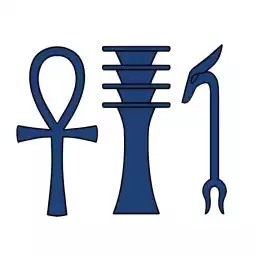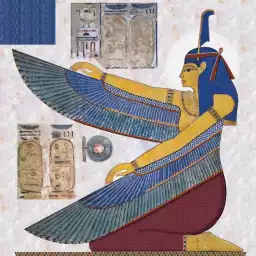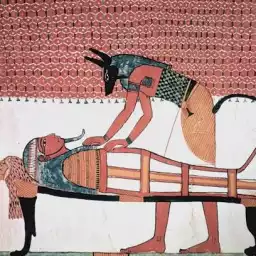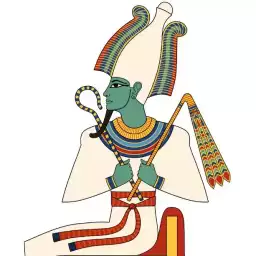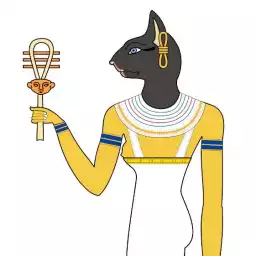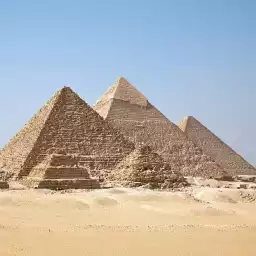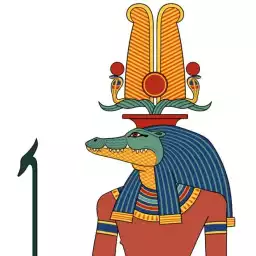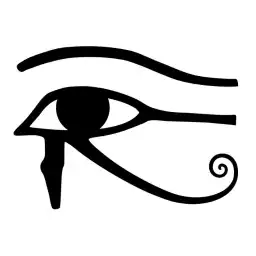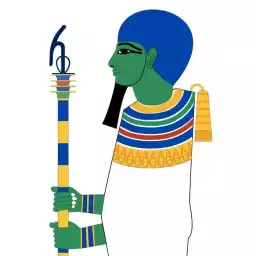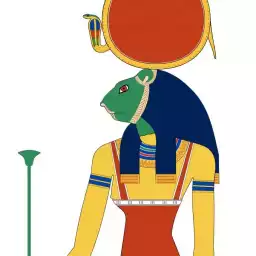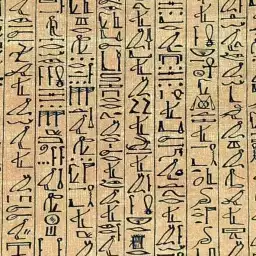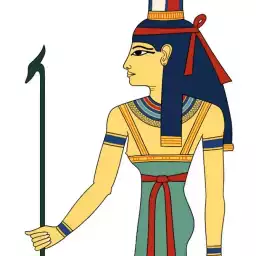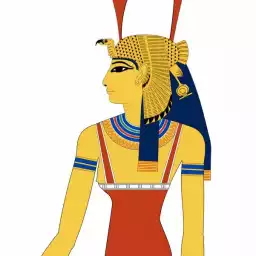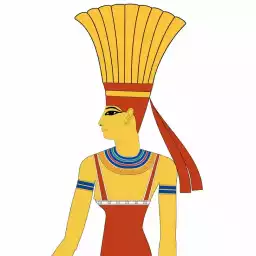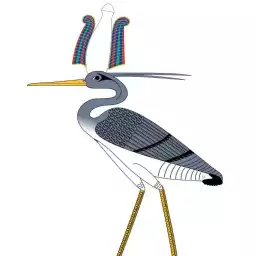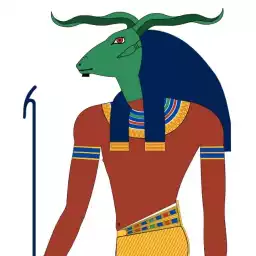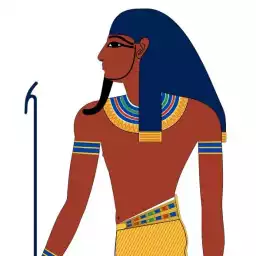
Egyptian Mythology Quiz
How much do you know about Egyptian mythology?
Embark on a journey through the sands of time and test your knowledge of ancient Egypt's gods, goddesses, and legendary tales.
From the powerful sun god Ra to the intricate stories of the afterlife, Egyptian mythology offers a fascinating glimpse into a civilization that captivated the imagination of the world.
Are you ready to test your knowledge of the ancient Egypt?
Start the Egyptian Mythology Test
Questions and answers about Egyptian Myths
-
Who is Ra in Egyptian mythology?
 Jeff Dahl, CC BY-SA 4.0Ra, also known as Re, is the ancient Egyptian sun god, one of the most important deities in Egyptian mythology. He is often depicted with the head of a falcon crowned with a solar disk encircled by a cobra. Ra was believed to travel across the sky in his solar boat during the day, descending into the underworld at sunset, symbolizing death and rebirth.
Jeff Dahl, CC BY-SA 4.0Ra, also known as Re, is the ancient Egyptian sun god, one of the most important deities in Egyptian mythology. He is often depicted with the head of a falcon crowned with a solar disk encircled by a cobra. Ra was believed to travel across the sky in his solar boat during the day, descending into the underworld at sunset, symbolizing death and rebirth.- Sun god
- War god
- God of the dead
- God of wisdom
-
What is Anubis known for in Egyptian mythology?
 Jeff Dahl, CC BY-SA 4.0Anubis is known as the god of mummification and the afterlife in Egyptian mythology. He is depicted as a man with the head of a jackal, an animal associated with cemeteries because it was often seen scavenging near graves. Anubis played a crucial role in the embalming process and the weighing of the heart, determining the worthiness of souls to enter the realm of the dead.
Jeff Dahl, CC BY-SA 4.0Anubis is known as the god of mummification and the afterlife in Egyptian mythology. He is depicted as a man with the head of a jackal, an animal associated with cemeteries because it was often seen scavenging near graves. Anubis played a crucial role in the embalming process and the weighing of the heart, determining the worthiness of souls to enter the realm of the dead.- Dead and afterlife
- Sun and rebirth
- Creation and magic
- Harvest and fertility
-
What is the significance of the Nile River in Egyptian mythology?
 Marc Ryckaert (MJJR), CC BY 3.0The Nile River is of central importance in Egyptian mythology, viewed as the lifeblood of Egypt. The river was associated with annual floods that enriched the soil and allowed agriculture to flourish. This natural cycle of renewal was linked to the myths of Osiris and his rebirth, symbolizing fertility and regeneration. The Nile was also considered a divine river, home to gods and the pathway to the afterlife.
Marc Ryckaert (MJJR), CC BY 3.0The Nile River is of central importance in Egyptian mythology, viewed as the lifeblood of Egypt. The river was associated with annual floods that enriched the soil and allowed agriculture to flourish. This natural cycle of renewal was linked to the myths of Osiris and his rebirth, symbolizing fertility and regeneration. The Nile was also considered a divine river, home to gods and the pathway to the afterlife.- Source of life and fertility
- Pathway to the underworld
- All of the above
- None of the above
-
Who is Isis in Egyptian mythology?
 Jeff Dahl, CC BY-SA 4.0Isis is a major goddess in Egyptian mythology, known for her roles as a divine mother, wife, and magic healer. She is celebrated for her intelligence and cunning. Isis was the wife of Osiris and played a crucial role in his resurrection, making her also associated with rebirth and the afterlife. She is often depicted as a woman wearing a throne-shaped crown, symbolizing her status as a queen of the gods.
Jeff Dahl, CC BY-SA 4.0Isis is a major goddess in Egyptian mythology, known for her roles as a divine mother, wife, and magic healer. She is celebrated for her intelligence and cunning. Isis was the wife of Osiris and played a crucial role in his resurrection, making her also associated with rebirth and the afterlife. She is often depicted as a woman wearing a throne-shaped crown, symbolizing her status as a queen of the gods.- Goddess of magic and motherhood
- Goddess of war and harvest
- Goddess of the sky and dead
- Goddess of wisdom and fertility
-
What is the Egyptian Book of the Dead?
 Hunefer, Public domainThe Egyptian Book of the Dead is a collection of spells, prayers, and incantations intended to assist the deceased in navigating the afterlife. It includes guidance on how to overcome obstacles, pass judgment, and achieve eternal life with the gods. This "book" was not a single document but a compilation of texts that varied over centuries, typically inscribed on tomb walls, sarcophagi, or papyrus scrolls.
Hunefer, Public domainThe Egyptian Book of the Dead is a collection of spells, prayers, and incantations intended to assist the deceased in navigating the afterlife. It includes guidance on how to overcome obstacles, pass judgment, and achieve eternal life with the gods. This "book" was not a single document but a compilation of texts that varied over centuries, typically inscribed on tomb walls, sarcophagi, or papyrus scrolls.- A guide for the deceased to the afterlife
- A record of a person’s life deeds
- A religious scripture recited by priests
- A historical chronicle of ancient Egypt
-
Who is Horus in Egyptian mythology?
 Jeff Dahl, CC BY-SA 4.0Horus is one of the most significant ancient Egyptian deities, often depicted as a falcon-headed man. He is the god of the sky, protection, and kingship. Horus is famously known for his battle with Set, the god of chaos, to avenge his father Osiris's death and reclaim the throne, symbolizing the eternal struggle between order and chaos.
Jeff Dahl, CC BY-SA 4.0Horus is one of the most significant ancient Egyptian deities, often depicted as a falcon-headed man. He is the god of the sky, protection, and kingship. Horus is famously known for his battle with Set, the god of chaos, to avenge his father Osiris's death and reclaim the throne, symbolizing the eternal struggle between order and chaos.- God of the sky, protection, and kingship
- God of the underworld, rebirth and afterlife
- God of knowledge, time, and war
- God of harvest, love, and hunt
-
What is the myth of Osiris and Isis?
 Fondo Antiguo de la Biblioteca de la Universidad de Sevilla from Sevilla, España, CC BY 2.0The myth of Osiris and Isis is one of the most compelling narratives in Egyptian mythology. It tells the story of Osiris, the god of the underworld and judge of the dead, who was murdered and dismembered by his brother Set out of jealousy. Isis, Osiris's wife, collected his body parts, reassembled them, and used her magical powers to resurrect him, leading to the birth of their son, Horus. This myth emphasizes themes of loyalty, resurrection, and righteous kingship.
Fondo Antiguo de la Biblioteca de la Universidad de Sevilla from Sevilla, España, CC BY 2.0The myth of Osiris and Isis is one of the most compelling narratives in Egyptian mythology. It tells the story of Osiris, the god of the underworld and judge of the dead, who was murdered and dismembered by his brother Set out of jealousy. Isis, Osiris's wife, collected his body parts, reassembled them, and used her magical powers to resurrect him, leading to the birth of their son, Horus. This myth emphasizes themes of loyalty, resurrection, and righteous kingship.- A story of death, resurrection, and vengeance
- A tale of creation and the origin of the Nile
- A historical account of ancient Egyptian rulers
- An allegory for the seasonal cycles
-
Who is the Egyptian goddess of love and beauty?
 Jeff Dahl, CC BY-SA 4.0Hathor is widely regarded as the goddess of love, beauty, music, and joy in Egyptian mythology. She is often depicted as a cow or as a woman with cow's horns, between which rests the solar disk, symbolizing her connection to the sun god Ra. Hathor's worship was widespread, and she was deeply beloved among the ancient Egyptians.
Jeff Dahl, CC BY-SA 4.0Hathor is widely regarded as the goddess of love, beauty, music, and joy in Egyptian mythology. She is often depicted as a cow or as a woman with cow's horns, between which rests the solar disk, symbolizing her connection to the sun god Ra. Hathor's worship was widespread, and she was deeply beloved among the ancient Egyptians.- Hathor
- Isis
- Ma'at
- Sekhmet
-
What is the role of the Sphinx in Egyptian mythology?
 Petar Milošević, CC BY-SA 4.0The Sphinx, a mythical creature with the body of a lion and the head of a human, primarily represents protection. Found at major ceremonial sites, such as the famous Great Sphinx of Giza, it is believed to guard the sacred areas against any spiritual or physical threats, symbolizing royal strength and wisdom.
Petar Milošević, CC BY-SA 4.0The Sphinx, a mythical creature with the body of a lion and the head of a human, primarily represents protection. Found at major ceremonial sites, such as the famous Great Sphinx of Giza, it is believed to guard the sacred areas against any spiritual or physical threats, symbolizing royal strength and wisdom.- Guardian of sacred sites
- Guide to the underworld
- Symbol of chaos and destruction
- Messenger between the gods and humans
-
Who is Set in Egyptian mythology?
 Eternal Space, CC BY-SA 4.0Set is the god of chaos, storms, deserts, and war in Egyptian mythology. He is depicted as a figure with a unique animal head that features a curved snout, square ears, and a forked tail. Set is notorious for murdering his brother Osiris and battling his nephew Horus, embodying the role of an antagonist within the mythological pantheon.
Eternal Space, CC BY-SA 4.0Set is the god of chaos, storms, deserts, and war in Egyptian mythology. He is depicted as a figure with a unique animal head that features a curved snout, square ears, and a forked tail. Set is notorious for murdering his brother Osiris and battling his nephew Horus, embodying the role of an antagonist within the mythological pantheon.- God of chaos and war
- God of the sun and rebirth
- Protector of the dead
- Creator of the world
-
What are the key symbols in Egyptian mythology?
 Eternal Space, CC BY-SA 4.0Egyptian mythology is rich with symbols, many of which represent divine protection, power, and the cycle of life and death. Notable symbols include the Ankh, representing eternal life; the Scarab, symbolizing rebirth and regeneration; the Djed pillar, signifying stability; and the Was scepter, representing power and authority.
Eternal Space, CC BY-SA 4.0Egyptian mythology is rich with symbols, many of which represent divine protection, power, and the cycle of life and death. Notable symbols include the Ankh, representing eternal life; the Scarab, symbolizing rebirth and regeneration; the Djed pillar, signifying stability; and the Was scepter, representing power and authority.- Ankh, Scarab, Djed, Was scepter
- Aten, Uraeus, Cartouche
- Ocean, Moon, Stars
- Papyrus, Hieroglyphs, Sphinx
-
Who is Thoth in Egyptian mythology?
 Jeff Dahl, CC BY-SA 4.0Thoth is the Egyptian god of the moon writing, knowledge, and wisdom. Known for his mediating power, he is often depicted as an ibis-headed man or as a baboon. Thoth was believed to be the scribe of the underworld, maintaining the universe's balance and order by recording the deeds of the dead.
Jeff Dahl, CC BY-SA 4.0Thoth is the Egyptian god of the moon writing, knowledge, and wisdom. Known for his mediating power, he is often depicted as an ibis-headed man or as a baboon. Thoth was believed to be the scribe of the underworld, maintaining the universe's balance and order by recording the deeds of the dead.- God of writing, knowledge, and wisdom
- God of the underworld and judgment
- Protector of the harvest and fertility
- God of the sun and healing
-
What is the concept of Ma'at in Egyptian beliefs?
 TYalaA, CC BY-SA 4.0Ma'at in Egyptian beliefs represents truth, balance, order, and justice. She is personified as a goddess often depicted with an ostrich feather on her head. Ma'at's principles were integral to Egyptian society and religion, influencing laws and moral standards to maintain cosmic harmony and prevent chaos.
TYalaA, CC BY-SA 4.0Ma'at in Egyptian beliefs represents truth, balance, order, and justice. She is personified as a goddess often depicted with an ostrich feather on her head. Ma'at's principles were integral to Egyptian society and religion, influencing laws and moral standards to maintain cosmic harmony and prevent chaos.- Truth, balance, order, and justice
- Creation, destruction, renewal
- Beauty, love, and motherhood
- War, chaos, death, and power
-
What is the significance of mummification in Egyptian beliefs?
 self, Public domainMummification in Egyptian beliefs was crucial for ensuring the deceased's survival in the afterlife. It involved preserving the body through elaborate rituals to prevent decay and allow the deceased to live again in the spiritual realm. Mummification was seen as essential for maintaining the continuity of life after death and for the eventual resurrection alongside the gods.
self, Public domainMummification in Egyptian beliefs was crucial for ensuring the deceased's survival in the afterlife. It involved preserving the body through elaborate rituals to prevent decay and allow the deceased to live again in the spiritual realm. Mummification was seen as essential for maintaining the continuity of life after death and for the eventual resurrection alongside the gods.- Ensuring survival in the afterlife
- Symbolizing royalty and power
- Protection from evil spirits
- Representation of rebirth and renewal
-
Who is the Egyptian god of the underworld?
 Eternal Space, CC0Osiris is the Egyptian god of the underworld and judge of the dead. He is one of the most important and enduring figures in Egyptian mythology, often depicted as a mummified king. Osiris's myth involves his murder, resurrection, and eternal rule over the afterlife, embodying regeneration and justice.
Eternal Space, CC0Osiris is the Egyptian god of the underworld and judge of the dead. He is one of the most important and enduring figures in Egyptian mythology, often depicted as a mummified king. Osiris's myth involves his murder, resurrection, and eternal rule over the afterlife, embodying regeneration and justice.- Osiris
- Anubis
- Seth
- Thoth
-
What is the story of Ra's daily journey?
 Jeff Dahl, CC BY-SA 4.0Ra's daily journey is a fundamental myth in Egyptian mythology, describing his voyage across the sky in a solar boat. Each morning, Ra emerges in the east, representing birth and renewal. He travels through the sky by day, providing light and warmth, and descends into the underworld at sunset, where he must navigate the dangers of the night before being reborn at dawn.
Jeff Dahl, CC BY-SA 4.0Ra's daily journey is a fundamental myth in Egyptian mythology, describing his voyage across the sky in a solar boat. Each morning, Ra emerges in the east, representing birth and renewal. He travels through the sky by day, providing light and warmth, and descends into the underworld at sunset, where he must navigate the dangers of the night before being reborn at dawn.- Traveling across the sky in a solar boat
- Guiding souls to the afterlife
- Battling chaos serpents
- Creating the stars and planets
-
Who is Bastet in Egyptian mythology?
 Gunawan Kartapranata, CC BY-SA 3.0Bastet is the Egyptian goddess of home, fertility, and childbirth, often depicted as a lioness or as a woman with the head of a lioness or domestic cat. She embodies protection, especially of the home and family, and was also associated with music, dance, and joy, reflecting her role as a bringer of harmony and happiness.
Gunawan Kartapranata, CC BY-SA 3.0Bastet is the Egyptian goddess of home, fertility, and childbirth, often depicted as a lioness or as a woman with the head of a lioness or domestic cat. She embodies protection, especially of the home and family, and was also associated with music, dance, and joy, reflecting her role as a bringer of harmony and happiness.- Goddess of home, fertility, and childbirth
- Goddess of the moon and night
- Goddess of wisdom and knowledge
- Goddess of war and destruction
-
What is the importance of the pyramids in Egyptian beliefs?
 Ricardo Liberato, CC BY-SA 2.0The pyramids, monumental structures built as the tombs of pharaohs, are central to Egyptian beliefs about the afterlife. They were designed to ensure the eternal life of the kings, serving as gateways to the afterlife. The pyramids were also believed to protect the pharaohs' souls from evil forces, ensuring their safe passage and resurrection alongside the gods.
Ricardo Liberato, CC BY-SA 2.0The pyramids, monumental structures built as the tombs of pharaohs, are central to Egyptian beliefs about the afterlife. They were designed to ensure the eternal life of the kings, serving as gateways to the afterlife. The pyramids were also believed to protect the pharaohs' souls from evil forces, ensuring their safe passage and resurrection alongside the gods.- Tombs ensuring eternal life and protection in the afterlife
- Monuments to celebrate victories in battle
- Observatories for astronomical purposes
- Palaces for the reigning pharaohs to glorify them above their subjects.
-
Who is Sobek in Egyptian mythology?
 Eternal Space, CC BY-SA 4.0, via Wikimedia CommonsSobek is the Egyptian god associated with the Nile crocodile, or depicted directly as a crocodile. He is revered as the god of the Nile, strength, power, and fertility. Sobek's ambivalent nature reflects both protective aspects, guarding the Egyptian people and pharaohs, and aggressive traits, aligning him with military prowess and pharaonic power.
Eternal Space, CC BY-SA 4.0, via Wikimedia CommonsSobek is the Egyptian god associated with the Nile crocodile, or depicted directly as a crocodile. He is revered as the god of the Nile, strength, power, and fertility. Sobek's ambivalent nature reflects both protective aspects, guarding the Egyptian people and pharaohs, and aggressive traits, aligning him with military prowess and pharaonic power.- God of the Nile, strength, and fertility
- God of the sun and creation
- God of the underworld and judgment
- God of wisdom and writing
-
What does the Eye of Horus symbolize?
 Jeff Dahl, CC BY-SA 4.0The Eye of Horus, also known as the Wadjet, is an ancient Egyptian symbol representing protection, royal power, and good health. It is thought to have healing and protective powers and is used as a protective amulet. The Eye of Horus is also associated with the concept of sacrifice, healing, restoration, and wholeness.
Jeff Dahl, CC BY-SA 4.0The Eye of Horus, also known as the Wadjet, is an ancient Egyptian symbol representing protection, royal power, and good health. It is thought to have healing and protective powers and is used as a protective amulet. The Eye of Horus is also associated with the concept of sacrifice, healing, restoration, and wholeness.- Protection, royal power, and good health
- War, chaos, and destruction
- Rebirth, the afterlife, and immortality
- Agriculture, harvest, and fertility
-
Who is Ptah in Egyptian mythology?
 Jeff Dahl, CC BY-SA 4.0Ptah is a creator god in Egyptian mythology, regarded as the god of craftsmen, architects, and sculpture. He is often depicted as a mummified man, holding a staff that combines the symbols of life (ankh), stability (djed), and power (was scepter). Ptah is credited with creating the world through the thoughts of his heart and words of his mouth, embodying the idea that thought and word can manifest into reality.
Jeff Dahl, CC BY-SA 4.0Ptah is a creator god in Egyptian mythology, regarded as the god of craftsmen, architects, and sculpture. He is often depicted as a mummified man, holding a staff that combines the symbols of life (ankh), stability (djed), and power (was scepter). Ptah is credited with creating the world through the thoughts of his heart and words of his mouth, embodying the idea that thought and word can manifest into reality.- God of craftsmen, architects, and creation
- God of war and soldiers
- God of the harvest and fertility
- God of the dead and embalming, protector of the afterlife
-
Who is Sekhmet in Egyptian mythology?
 Jeff Dahl, CC BY-SA 4.0Sekhmet is a powerful and fearsome goddess in Egyptian mythology, depicted as a lioness or as a woman with the head of a lioness. She is known as the goddess of war, destruction, and healing. Her dual nature reflects her ability to bring both disease and cure, underscoring her role as a protector of the pharaohs and a guide for their warriors in battle.
Jeff Dahl, CC BY-SA 4.0Sekhmet is a powerful and fearsome goddess in Egyptian mythology, depicted as a lioness or as a woman with the head of a lioness. She is known as the goddess of war, destruction, and healing. Her dual nature reflects her ability to bring both disease and cure, underscoring her role as a protector of the pharaohs and a guide for their warriors in battle.- Goddess of war, destruction, and healing
- Goddess of love and beauty
- Goddess of the moon and hunting
- Goddess of wisdom and knowledge
-
What is the significance of hieroglyphics in Egyptian culture?
 British Museum, Public domainHieroglyphics are a system of writing that was used in ancient Egypt for more than 3,000 years. These elaborate characters, which include pictorial symbols, were used for religious literature on papyrus and wood, and for inscriptions on the walls of temples and tombs. Hieroglyphics were not only a means of communication but also a tool for preserving the culture and beliefs of ancient Egypt, ensuring that the civilization's practices, rituals, and history were passed down through generations.
British Museum, Public domainHieroglyphics are a system of writing that was used in ancient Egypt for more than 3,000 years. These elaborate characters, which include pictorial symbols, were used for religious literature on papyrus and wood, and for inscriptions on the walls of temples and tombs. Hieroglyphics were not only a means of communication but also a tool for preserving the culture and beliefs of ancient Egypt, ensuring that the civilization's practices, rituals, and history were passed down through generations.- Means of communication and cultural preservation
- Method for recording time and calendars
- Decorative art used in pottery and jewelry
- Secret code used only by the pharaohs and priests
-
Nephthys Who is in Egyptian mythology?
 Eternal Space, CC BY-SA 4.0Nephthys is an ancient Egyptian goddess, associated with mourning, the night, and service to the dead. She is often depicted alongside her sister Isis in funerary rites, protecting and mourning the dead. Nephthys is considered a protective goddess who assists the deceased in their journey through the afterlife, using her magic to provide safety and comfort.
Eternal Space, CC BY-SA 4.0Nephthys is an ancient Egyptian goddess, associated with mourning, the night, and service to the dead. She is often depicted alongside her sister Isis in funerary rites, protecting and mourning the dead. Nephthys is considered a protective goddess who assists the deceased in their journey through the afterlife, using her magic to provide safety and comfort.- Goddess of mourning, the night, and service to the dead
- Goddess of the harvest and fertility
- Goddess of wisdom and magic
- Goddess of war and chaos
-
What are Canopic Jars in Egyptian beliefs?
 Metropolitan Museum of Art, CC0Canopic Jars are ritual items used in ancient Egyptian burial customs to store and preserve the viscera of their owner for the afterlife. Made of materials like limestone, pottery, and later alabaster, these jars ensured the safety and sanctity of the internal organs that were believed to be needed in the afterlife. Each jar typically represents one of the four sons of Horus, guarding a specific organ and being protected by a specific goddess.
Metropolitan Museum of Art, CC0Canopic Jars are ritual items used in ancient Egyptian burial customs to store and preserve the viscera of their owner for the afterlife. Made of materials like limestone, pottery, and later alabaster, these jars ensured the safety and sanctity of the internal organs that were believed to be needed in the afterlife. Each jar typically represents one of the four sons of Horus, guarding a specific organ and being protected by a specific goddess.- Containers for preserving internal organs for the afterlife
- Decorative urns used to store offerings to the gods
- Sacred vessels used to carry water from the Nile
- Symbolic pots used in farming rituals
-
Who is Mut in Egyptian mythology?
 Jeff Dahl, CC BY-SA 4.0, via Wikimedia CommonsMut is an ancient Egyptian goddess, often portrayed as a mother goddess with multiple aspects. She is commonly depicted wearing a vulture headdress and double crown, representing her power and status. Mut's role expanded over time, embodying traits of motherhood, authority, and nature, and she was revered as the queen of the gods, closely associated with both Amun and Khonsu in the Theban triad.
Jeff Dahl, CC BY-SA 4.0, via Wikimedia CommonsMut is an ancient Egyptian goddess, often portrayed as a mother goddess with multiple aspects. She is commonly depicted wearing a vulture headdress and double crown, representing her power and status. Mut's role expanded over time, embodying traits of motherhood, authority, and nature, and she was revered as the queen of the gods, closely associated with both Amun and Khonsu in the Theban triad.- Goddess of motherhood, authority, and nature
- Goddess of destruction and healing
- Goddess of the underworld and rebirth
- Goddess of wisdom and knowledge
-
Who is Anuket in Egyptian mythology?
 Jeff Dahl, CC BY-SA 4.0Anuket, often depicted as a woman wearing a tall feathered crown, is the ancient Egyptian goddess of the Nile's cataracts and lower reaches. Her role primarily concerned the aspects of nourishment and the purifying flow of water, which were crucial for agriculture. Anuket was also associated with the annual flooding of the Nile, celebrated in a festival known as the Feast of Anuket, which heralded the fertile silt and water rejuvenating the farmlands.
Jeff Dahl, CC BY-SA 4.0Anuket, often depicted as a woman wearing a tall feathered crown, is the ancient Egyptian goddess of the Nile's cataracts and lower reaches. Her role primarily concerned the aspects of nourishment and the purifying flow of water, which were crucial for agriculture. Anuket was also associated with the annual flooding of the Nile, celebrated in a festival known as the Feast of Anuket, which heralded the fertile silt and water rejuvenating the farmlands.- Goddess of the Nile's cataracts and nourishment
- Goddess of childbirth and fertility
- Goddess of magic and healing
- Goddess of war and strength
-
What is the legend of the Bennu bird in Egyptian mythology?
 Jeff Dahl, CC BY-SA 4.0The Bennu bird in Egyptian mythology symbolizes rebirth and renewal. Often linked to the sun, creation, and immortality, the Bennu bird is associated with Osiris and viewed as the soul of Ra, the sun god. The legend states that the Bennu bird arose from the ashes of a holy fire and would live for 500 years before rebirthing itself, symbolizing the cycle of rise, death, and resurrection that is central to Egyptian cosmology.
Jeff Dahl, CC BY-SA 4.0The Bennu bird in Egyptian mythology symbolizes rebirth and renewal. Often linked to the sun, creation, and immortality, the Bennu bird is associated with Osiris and viewed as the soul of Ra, the sun god. The legend states that the Bennu bird arose from the ashes of a holy fire and would live for 500 years before rebirthing itself, symbolizing the cycle of rise, death, and resurrection that is central to Egyptian cosmology.- Symbolizes rebirth, creation, and the cycle of life
- Represents chaos and destruction from which new life springs
- Guardian of secrets and mystical knowledge
- Protector of the dead in their journey through the underworld
-
What are the roles of the different animal-headed gods in Egyptian mythology?
 Metropolitan Museum of Art, CC0, via Wikimedia CommonsAnimal-headed gods in Egyptian mythology represent the anthropomorphic qualities of various deities, each symbolizing different aspects of life and nature. For instance, Anubis, with a jackal's head, is the god of embalming and the dead; Sobek, with a crocodile's head, symbolizes the strength and fertility of the Nile; and Thoth, often depicted with an ibis head, embodies wisdom and writing.
Metropolitan Museum of Art, CC0, via Wikimedia CommonsAnimal-headed gods in Egyptian mythology represent the anthropomorphic qualities of various deities, each symbolizing different aspects of life and nature. For instance, Anubis, with a jackal's head, is the god of embalming and the dead; Sobek, with a crocodile's head, symbolizes the strength and fertility of the Nile; and Thoth, often depicted with an ibis head, embodies wisdom and writing.- Symbolize different aspects of life and nature
- Represent ancient kings and their powers
- Act as guardians of the underworld
- Are celestial beings controlling the stars
-
Who is Khnum in Egyptian mythology?
 Jeff Dahl, CC BY-SA 4.0Khnum, depicted as a ram-headed god, is the ancient Egyptian god of water and fertility, closely associated with the inundation of the Nile. He is also revered as a creator deity who molded humans from clay on his potter's wheel, infusing them with life, and thus holds a dual role of creation and nurturing through the waters of the Nile.
Jeff Dahl, CC BY-SA 4.0Khnum, depicted as a ram-headed god, is the ancient Egyptian god of water and fertility, closely associated with the inundation of the Nile. He is also revered as a creator deity who molded humans from clay on his potter's wheel, infusing them with life, and thus holds a dual role of creation and nurturing through the waters of the Nile.- God of water, fertility, and creation
- God of the sun and light
- God of war and protection
- God of the underworld and afterlife
-
What is the story of the creation of the world in Egyptian mythology?
 Jeff Dahl, CC BY-SA 4.0, via Wikimedia CommonsThe story of the creation in Egyptian mythology varies by region and era, but one common tale is that of the god Atum. Emerging from the chaotic waters of Nun, Atum created himself, using his own thoughts and will. He then spawned Shu (air) and Tefnut (moisture), who later gave birth to Geb (earth) and Nut (sky), setting the stage for the creation of the world and the other gods.
Jeff Dahl, CC BY-SA 4.0, via Wikimedia CommonsThe story of the creation in Egyptian mythology varies by region and era, but one common tale is that of the god Atum. Emerging from the chaotic waters of Nun, Atum created himself, using his own thoughts and will. He then spawned Shu (air) and Tefnut (moisture), who later gave birth to Geb (earth) and Nut (sky), setting the stage for the creation of the world and the other gods.- Atum created from Nun and birthed the first gods
- Ra created the world from a cosmic egg
- Ptah spoke the world into existence
- Osiris used magic to shape the earth and heavens
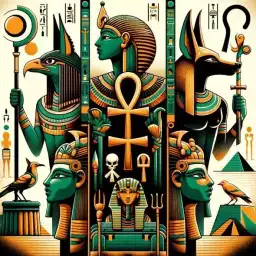
Egyptian Legends and Myths
Egyptian mythology is a rich and intricate system of beliefs and legends that played a central role in the culture of ancient Egypt. It encompassed the gods, goddesses, and supernatural beings believed to influence the natural world and the lives of the pharaohs who ruled Egypt. Here are some key aspects of Egyptian mythology:
Gods and Goddesses
Egyptian deities represented various aspects of nature, society, and humanity. Major gods included:
- Ra: The sun god, one of the most important in Egyptian mythology. He was believed to travel across the sky during the day and through the underworld at night.
- Osiris: God of the afterlife, the dead, and resurrection. Osiris's story of death and rebirth was central to Egyptian beliefs about the afterlife.
- Isis: Wife of Osiris and mother of Horus; a protective goddess who used magical spells to help people in need.
- Horus: The falcon-headed god of the sky, and protector of the ruler of Egypt. Horus was often depicted as a falcon or as a man with a falcon's head.
- Anubis: The jackal-headed god associated with mummification and the afterlife. Anubis presided over the embalming process and accompanied dead kings in the afterworld.
- Seth: God of chaos, violence, deserts, and storms, often depicted as the antagonist of Osiris and Horus.
Cosmology
Egyptians viewed the universe as an orderly and interconnected entity governed by Ma'at, or cosmic order, justice, and harmony. This concept affected every aspect of Egyptian life and governance, including their rituals, temple worship, and the pharaoh's role as both ruler and bridge between the gods and humans.
Afterlife
Belief in the afterlife was strong in Egyptian culture. They held that after death, one would enter the Duat, or underworld, to be judged by Osiris and other deities. The heart of the deceased would be weighed against the feather of Ma'at. Those found just could enter the paradise of the Field of Reeds, while those who failed were devoured by Ammit, the soul-eater.
Symbols and Practices
Egyptian mythology was rich in symbols:
- Ankh: Symbol of life.
- Scarab: Represented rebirth and regeneration.
-Djed: Symbolized stability.
- Was scepter: Represented power and dominion.
Mythological Tales
Stories were a key component of Egyptian mythology, often involving the gods in various aspects of life, explaining natural phenomena, or legitimizing the royal lineage. These stories were not only religious but also served educational and political purposes.
Egyptian mythology remains influential, its symbols and deities appearing in art, literature, and popular culture worldwide, underscoring its lasting allure and mystery.
Are you fascinated by ancient mythologies? Put your understanding to the test with our Quiz on Mythologies!
